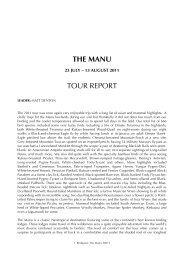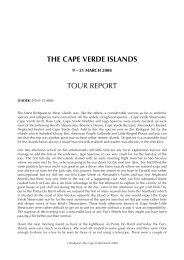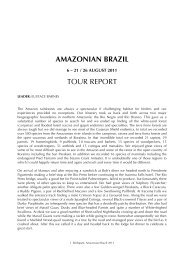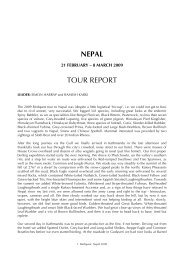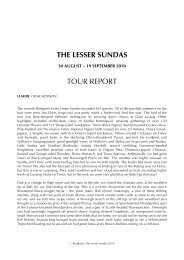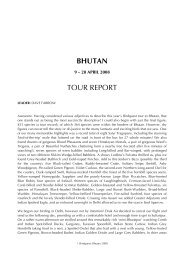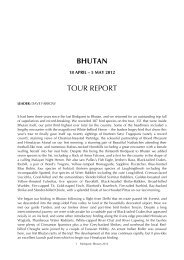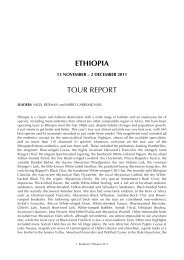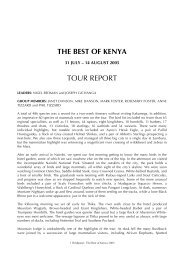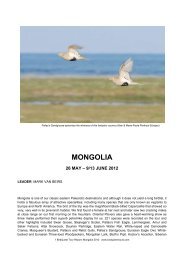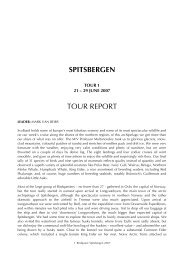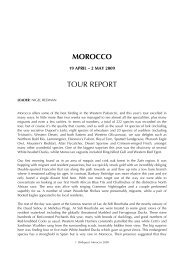INDONESIA (REMOTE EASTERN) REP 10 - Birdquest
INDONESIA (REMOTE EASTERN) REP 10 - Birdquest
INDONESIA (REMOTE EASTERN) REP 10 - Birdquest
You also want an ePaper? Increase the reach of your titles
YUMPU automatically turns print PDFs into web optimized ePapers that Google loves.
had two different species of cuscus, and some really stunning butterflies and dragonflies, many of<br />
which were regional endemics.<br />
The tour began on the little-visited island of Buru, after an overnight ferry journey from Ambon, the<br />
capital of South Maluku Province. We were a bit sorry to miss-out on seawatching but at least we<br />
slept for most of the trip. On arrival, we quickly checked into our hotel and then headed off for some<br />
introductory birding in some lowland forest patches at Waslabi and Air Mandidi, south-west of<br />
Namlea. Our first Buru endemics were soon rolling in, with Buru Golden Bulbul (split from Southern<br />
Golden), Buru Drongo (split from Spangled), Black-tipped Monarch, Buru Friarbird, Buru<br />
Flowerpecker (split from Flame-breasted), and Buru White-eye all giving themselves up easily. Other<br />
good birds in these areas were a nice pair of White-throated Pigeons that flew over, Superb Fruitdove,<br />
Buru (or Spectacled) Imperial Pigeon, Moluccan Cuckoo (i.e. the local form of Rusty-breasted<br />
in this case), Australian Koel, Seram Swiftlet (split from Moluccan), flocks of migrant White-throated<br />
Needletails soaring over the ridges, the superb Moustached Treeswift, Pale Cicadabird, White-naped<br />
Monarch, Slaty Flycatcher, Drab Whistler, Black Sunbird, Black-breasted Sunbird (split from Olivebacked),<br />
and Black-faced Munia. Air Mandidi had some wetlands, which supported Wandering<br />
Whistling-duck, Australian Swamphen, and Australian Reed-warbler. En route between sites and at<br />
lunch, we also scanned cultivation. A huge swirling mass of at least 150 Oriental Pratincoles was<br />
unexpected, and we also saw two Spotted Harriers. We finished the day trying to get views of our<br />
first Forsten’s Scrubfowls, which were calling back to us near their mound.<br />
Our second day took us further along the coast to accommodation at Waspait Resort Buru, and we<br />
also explored the Waipoti (Wae Putih) Logging Road. At the latter we found our first Buru Rackettails,<br />
without realizing how common they would later become, and glimpsed Buru Bush-warbler<br />
(split from Chestnut-backed). This was not a great site however.<br />
The next day we were off to the hills in 4WD vehicles for some serious trekking as we attempted to<br />
track-down the high-elevation endemics – an attempt that provided us all with many challenging<br />
moments. Reaching the higher levels of the Wamlana Logging Road, we made some relatively brief<br />
stops, first for large numbers of Buru Racket-tails and then for scope views of the amazing Redbreasted<br />
Pygmy-parrot. At the end of the drivable logging road, we met-up with a large band of<br />
porters, and set off with our guides. The plan was to hike to a village at the foot of the higher<br />
mountains west of Danau Rana, a large volcanic lake in the centre of the island. We had not gone far<br />
when the first of a number of streams had to be forded. We were, in general, following the course of<br />
a larger river and between each tributary-crossing there was a slippery scramble up a ridge and then<br />
down to the next stream. But after several hours and a break for lunch we descended to walk<br />
alongside, and then increasingly in, the muddy margins of the main river. When it started to rain our<br />
earlier efforts to keep our feet dry by taking shoes and socks off to ford each stream seemed to be<br />
rather pointless and we trudged on, little realizing that our feet would hardly be dry for the next four<br />
days! After about six hours we noticed some tell-tale rubbish on the path and soon afterwards some<br />
graveyards – we were nearing the village of Lemampoli. There was a sting-in-the-tail however, as the<br />
village was on the other side of a river and we had a knee-deep torrent swollen by the rain to cross<br />
before we arrived in the communal village area; to be closely examined by the curious locals, who<br />
had probably rarely seen foreigners before. The village was rather an enigma as it consisted of about<br />
40 almost identical buildings with sheet-iron roofs. Quite why it was here and what all the people<br />
did was hard to fathom. One house boasted a generator and therefore a TV, but otherwise there was<br />
no electricity. The only other signs of Western civilization were the football shirts worn by the<br />
children. After a lot of discussion we were all billeted into one pokey dark building, for a rather<br />
uncomfortable night.<br />
2 <strong>Birdquest</strong>: Remote Eastern Indonesia 20<strong>10</strong>




